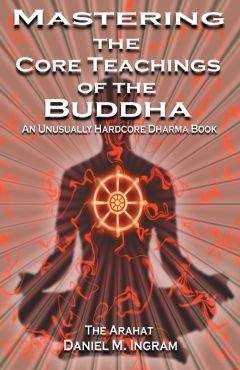Daniel Ingram - Mastering the Core Teachings of Buddha - An Unusually Hardcore Dharma Book
На электронном книжном портале my-library.info можно читать бесплатно книги онлайн без регистрации, в том числе Daniel Ingram - Mastering the Core Teachings of Buddha - An Unusually Hardcore Dharma Book. Жанр: Прочее издательство -, год 2004. В онлайн доступе вы получите полную версию книги с кратким содержанием для ознакомления, сможете читать аннотацию к книге (предисловие), увидеть рецензии тех, кто произведение уже прочитал и их экспертное мнение о прочитанном.
Кроме того, в библиотеке онлайн my-library.info вы найдете много новинок, которые заслуживают вашего внимания.

Daniel Ingram - Mastering the Core Teachings of Buddha - An Unusually Hardcore Dharma Book краткое содержание
Mastering the Core Teachings of Buddha - An Unusually Hardcore Dharma Book читать онлайн бесплатно
The details of the Ten Bhumi Model can be found in various
Mahayana texts, such as “The Large Sutra on Perfect Wisdom” and
“The Jewel Ornament of Liberation”. Chogyam Trungpa gives a nice description of it in The Myth of Freedom. Some texts also list other numbers of bhumis, such as 7 or 13, but they all share similar elements.
I do not consider myself an expert on this model, though I do understand the territory it covers. It is a very complex model that ascribes a wide range of exceedingly high and complex criteria involving emotions, paradigms, concentration abilities, perceptions, psychic powers and a whole host of other aspects to those of each stage. Thus, from my point of view, it is fraught with problems and assumes simultaneous, synchronized development on numerous axes, a notion I consider a bit naïve and idealized. However, like most of the teachings, it contains some very interesting points made in what I consider very unfortunate ways. Thus, I recommend you check it out cum grano salis, particularly if you want to understand Tibetan texts or do practices in that tradition.
Lining the model of the Bhumis up with the Four Paths also
involves some controversy. That the first bhumi is stream entry is straightforward. Beyond that, things get difficult. At points I have lined anagamihood up with anywhere from the 4th to the 7th bhumis and arahatship with anywhere from the 6th to 10th bhumis. These are not perfect correlations, and if you spend some time reading about the model you will see why. I recommend that you check out the sources 290
Models of the Stages of Enlightenment listed above if you are interested in further information about the Bhumis.
The biggest problem with this model is that it delineates the number of duplicates of one's self that one should be able to manifest as bodhisattvas at each bhumi, and as the bhumis progress the numbers quickly get so large as to be absurd. Why some whackjob included this bizarre ideal of many-fold bi-location in the model I have no idea, but somehow no Tibetan since has had the balls to throw it out, and so a thousand years later they are still stuck with it. Aside from these problems, the texts that describe the bhumis makes for very interesting reading, particularly in the middle stages of enlightenment.
THE TIBETAN FIVE PATH MODEL
While I am on the subject of the Tibetan Models, I will present the Tibetan Five Path Model. In this model, the details of which can be found in various places, such as Khenpo Karthar Rinpoche’s book Dharma Paths on Snow Lion. As that book does such a good job of explaining the dogma and is not expensive, I will give only a brief treatment of that model here.
First Path covers the territory from just beginning through the Arising and Passing Away, and is called the Path of Accumulation. In the territory of First Path, one accumulates direct insight into the true nature of sensations by direct investigation of impermanence and the selfless nature of phenomena, as one does in the first four ñanas.
Second Path, that of Unification, encompasses the territory from the Arising and Passing Away, through the Dark Night, to High Equanimity and the first taste of Stream Entry. These are perfect correlations also, and thus have already been described. Third Path is the Path of Seeing, and encompasses Stream Entry, and then begins the Fourth Path, that of Meditation, which encompasses the rest of the Ten Bhumis. Third Path is described as a plane taking off, and Fourth Path as it flying higher and higher. Fifth Path is that of Buddhahood. As you can see, the Five Path Model does not really add anything to the other models, but knowing it will help you understand the correlations between the terminology when you are trying to cross over between the writings and oral teachings of various traditions. Back to the generic models…
291
Models of the Stages of Enlightenment
THE ENERGETIC MODELS
In nearly the same vein as the Power Models are the Energetic Models. They tend to involve ideals that imply that enlightened beings will have all their energy channels clear, their chakras or energy centers all the right shape and color and all spinning in the correct direction, their aura large, regular, and some nice color such as white, gold or violet, and in general have perfected their energetic system, regardless of the particular energetic system model being used. The simple fact of multiple models and visions of what a perfected system should look like is already a red flag for anyone paying attention, as the various traditions can't even agree on how many chakras there are, much less the rest of the details. I have noticed that these things are very scriptable, meaning that one’s concepts of what is supposed to be happening can influence what one perceives in these areas. These models also leave much to be desired, and generally are referring to things that happen in the A&P
and the fourth jhana, as are the powers models.
Kundalini phenomena, where all the energy (prana, lung or chi) blasts through the central channel (shushumna), are very common in the A&P Event. Some traditions associate this event with awakening, though I consider this erroneous and premature, though I can understand why these stages impress people so much. It is during the A&P that some practitioners with a bent or talent for doing so may perceive energy channels, sometimes in outrageous detail, and be able to see chakras and the like. However, anyone who can do this in a sustained fashion will note the following: that in the Dark Night the channels are a mess in most people, and that in High Equanimity the focus shifts to experience itself, not nearly so much what is in that field of experience, and thus the channels can be difficult to perceive or a secondary background aspect of what is going on. Further, enlightened beings cycle all the time, their moods and health and other factors change all the time, and so what their channels are doing and how they perceive them will change all the time, leading to nothing resembling the stable, clean, orderly, perfected, predictable energetic state promised in the energetic models.
Thus, the energetic models are another example of a transient side effect of some people’s practice being incorporated into an ideal of 292
Models of the Stages of Enlightenment awakening. While energetic practices are very interesting and may lead to lots of insights and other nice effects, that is not the same thing as enlightened being having stable, perfected energetic systems. My friend Kenneth has asked me to add that there is something good that progressively awakening does to the channels and energetic system, and I have to agree. However, defining exactly what positive changes are made is difficult, and none of the models I have seen really do an adequate job or contain enough flexibility to accommodate how dynamic our energetic systems are. Suffice to say, this is one more set of models that is getting at something but contains much that needs revision.
THE SPECIFIC KNOWLEDGE MODELS
Specific Knowledge Models basically state or imply that
enlightenment will somehow magically provide hidden conceptual information about all sorts of specific things in life, such as the workings of particle physics, how to bring about world peace, who one’s disciples should marry, and the like. Some go further and state that
enlightenment progressively brings complete omniscience, meaning the ability to know everything about the whole universe simultaneously.
While these might seem to some people like reasonable things enlightened beings should somehow know, let’s include other things it might be good to know, such as how to create safe, inexpensive lithium ion batteries for electric cars, how to consistently beat the return of an S&P 500 index fund over the long haul, how to balance the federal deficit while providing everyone with good social support but not raising taxes, how to instantaneously make every blue-collar Republican realize that they are voting against their own self-interest, and how to build a fusion reactor that is safe, inexpensive, produces enough energy for everyone, and has no radioactive disposal issues. When you look at these, the concept of specific knowledge gained by merely seeing the true nature of ordinary sensations begins to seem as ridiculous as it really is.
The only specific thing I did gain a little insight into was the beauty of differential equations that discuss the oscillation from the imaginary quantities (potential) to real quantities (manifestation), but that’s about it. Other than a bunch of direct knowledge of how the mind works and 293
Models of the Stages of Enlightenment
a whole lot of knowledge about what a load of crap most religious and mystical dogma is, and that includes Buddhist Dogma, I didn’t really get any specific knowledge of anything else. So much for that idea…
THE PSYCHOLOGICAL MODELS
Here is another thing that didn’t happen: psychological perfection.
While the mainstream Western Buddhist world is absolutely drowning in notion that somehow Buddhist practice will either eliminate all their psychological “stuff” or cause them to become self-actualized in the good old psychoanalytical sense, nothing could be further from the truth except perhaps the Action Models. I think that I learned more about reasonable psychological health from reading one book on
Transactional Analysis (Vann Joines’ TA Today) than I did from over a decade of highly successful Buddhist meditation. That doesn’t mean that I have achieved perfect psychological health, not by a long shot!
Focusing on psychological growth is an epidemic disease in Western insight practice. Many of the major retreat centers that purport to foster insight practice in the US and Europe are actually bastions of the worst pop psychological bullshit retrofitted with a bastardized Buddhist front.
You have only to go to a few small group meetings on retreats, as I mentioned in Part II, to hear that the vast majority of people who are supposed to be doing insight practices are actually just wallowing in their own neurotic crap. Sure, they may be highly intelligent, super sophisticated, fantastically well-rationalized, pseudo-Buddhist practitioners of the Great Sacred Neurotic Crap Wallow, but they are wallowing just the same.
As I mentioned before, that this sort of behavior is tolerated on meditation retreats at all is mind-boggling, but that it gets reinforced and rewarded as often as it does is a crying shame that reflects as badly on the teachers as it does the practitioners. I have had insight teacher after insight teacher try to focus on what I was feeling and how my relationships were going when all I wanted to do was talk about my attempts at insight practices, as I assumed, often wrongly, that they were insight teachers.
While the dharma is vast, and the teachings of the wisdom traditions contain a lot of material for helping grow psychologically, that doesn’t mean that it has anything to do with awakening or insight practice at all, 294
Models of the Stages of Enlightenment and letting people get stuck there does them little service, if you ask me, which you clearly did, as you are reading this book. Again, as I said before, working on one’s psychological stuff can have its value, but I firmly believe that keeping the line between insight practice and psychological work drawn as firmly as possible is essential to doing either well.
Further, it is oh so easy to imagine that the teachers on the front cushion couldn’t possibly be as neurotic as we are, and before you know it we have the breeding ground for massive shadow sides, exploitation, isolation, and scandal just like we had with the models that purport emotional perfection. The Jet Set culture of teachers popping in, getting up on the front cushion, spouting their beautiful ideals, and jetting off to somewhere else before anyone can see them as the humans they really are only goes to reinforce these dangerous notions. It is just so easy to project all kinds of wondrous qualities on to them when the dream is so nicely laid out and the opportunities for reality testing so few. Clearly, that suits most of them just fine, or they would go more out of their way to counter those notions, but, as they quickly learn, countering those notions just doesn’t sell, and getting caught up in that sort of transference feels mighty friggin’ nice.
Thus, I think that the models that reinforce the notion that psychological perfection or freedom from our psychological stuff will come simply by seeing through the sense of a separate, permanent agent are a serious problem for these major reasons:
1) They simply aren’t true.
2) They cause practitioners to get caught up in their stuff rather than focusing on the Three Characteristics or something equivalent, thus squandering the vast majority of Western Buddhist practitioner’s scant retreat and practice time.
3) They allow teachers to be able to ride the hot air of these preposterous ideals to dangerous heights.
4) They contribute to the erroneous sense of the gap between this ordinary, human existence and awakening by creating unrealistic ideals and goals.
Most Buddhist practitioners that I know have something like one of the following belief structures:
295
Models of the Stages of Enlightenment
1) That awakening is impossible, so the best thing to try for is psychological or emotional health or perfection.
2) That awakening is psychological or emotional perfection, so by trying for psychological or emotional perfection one is doing the practices that lead to awakening.
3) That awakening involves psychological or emotional perfection, so it clearly is impossible, and by sitting they are trying to accomplish something else, but if you ask them what that is they are usually unable to answer clearly.
What is so ironic is that awakening is hard but clearly not
impossible, and not nearly as impossible as achieving psychological or emotional perfection. In fact, seeing sensations clearly enough to see that they are all just happening and coming and going is extremely straightforward once you finally realize that is what you are supposed to be doing. Further, when I think back on all the things I have done, including going to medical school, spending a year in India working as a volunteer there, and finishing a medical residency, I must say that the work I went through to get those things was significantly more than the work it took to get to stream entry and even arahatship. It is not that getting stream entry was easy, just not as hard as plenty of other things I have done. I attribute my success to a vast array of factors, but two that are relevant here are a tolerance for pain and having a good working model. That model was one that was blissfully free of the notion of emotional or psychological perfection.
When I think about what it would take to achieve freedom from all psychological stuff, the response that comes is this: life is about stuff.
Stuff is part of being alive. There is no way out of this while you are still living. There will be confusion, pain, miscommunication,
misinterpretation, maladaptive patterns of behavior, unhelpful emotional reactions, weird personality traits, neurosis and possibly much worse. There will be power plays, twisted psychological games, people with major personality disorders (which may include you), and craziness. The injuries continue right along with the healing and eventually the injuries win and we die. This is a fundamental teaching of the Buddha. I wish the whole Western Buddhist World would just get over this notion that these practices are all about getting to our Happy 296
Похожие книги на "Mastering the Core Teachings of Buddha - An Unusually Hardcore Dharma Book", Daniel Ingram
Daniel Ingram читать все книги автора по порядку
Daniel Ingram - все книги автора в одном месте читать по порядку полные версии на сайте онлайн библиотеки My-Library.Info.




